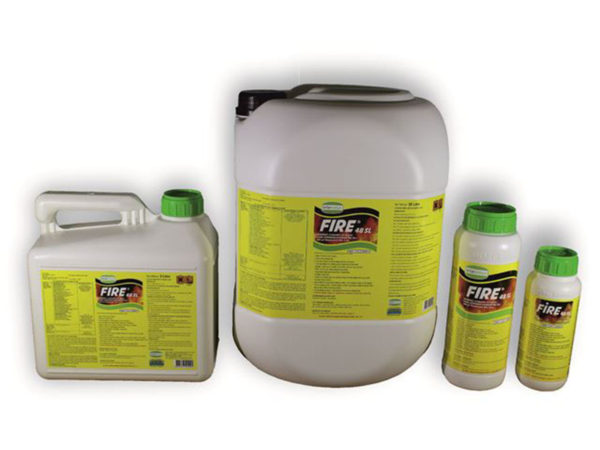

Explanation
APPLICATION PREPARATION AND USE
Preparation of the drug for application:
First, the sprayer tank is half filled with water, and then the required amount of the drug is mixed with water in a separate container and mixed well. It is poured into the tank of the tool and the required amount of water is added to the tank of the tool. It is mixed thoroughly and pulverized directly on weeds.
Usage of the drug:
The best result is obtained when weeds are actively growing. Care should be taken not to pulverize the green parts of the cultivated plants of the medicinal plant and the green saplings of the young seedlings. Since FİRE 48 SL is a systemically effective drug, soil tillage that will damage weeds should not be done before at least 4-5 days after the application, in order for the drug to penetrate the herbs. The ideal amount of water to be used per decare is 20-40 liters. In applications, for example; This goal is achieved by using fan-jet nozzles and operating the sprayer at low pressure. Do not spray with high pressure tools in very windy weather.
INFORMATION ABOUT RESISTANCE
The plant protection product named FİRE 48 SL is a herbicide classified as Group G / 9 according to its mechanism of action. Repeated applications of plant protection products with the same mechanism of action promote resistance development. For this reason, to delay developing resistance, do not exceed total application number of FİRE 48 SL in the same season. In cases where the application should be repeated, pay attention to the use of plant protection products with a different mechanism of action (except group G / 9).
MIXTURE STATUS
It can be used by mixing with 2,4-D Ester herbicides.
POISONING SYMPTOMS
Weakness, numbness, stomach pains.
FIRST AID MEASURES
Wash the body parts that touch the medicine very well, especially the eyes. If the medication has been swallowed, go to a doctor and take the medicine and label together.
In case of Skin Contact; See: Precautionary Statements (P302 + P352)
In Eye Contact; See: Precautionary Statements (P305 + P351 + P338)
ANTIDOTE and TREATMENT
It has no special antidote. Treatment is applied according to the symptoms.
NATIONAL POISON CENTER (UZEM) TEL: 114
CONTENTS
Glyphosate IPA Salt
HAZARDOUS EXPRESSIONS (H)
H315: Causes skin irritation.
H318: Causes serious eye damage.
H411: Long lasting, toxic effect in the aquatic environment.
Precautionary Statements (P)
P273: Avoid release to the environment.
P302 + P352: IF ON SKIN: Wash with plenty of soap and water.
P305 + P351 + P338: IF IN EYES: Rinse carefully with water for several minutes. Remove contact lenses if fitted and easy to do. Continue rinsing.
P310: Call the POISON CENTER or doctor / physician immediately.
P332 + P313: If skin irritation occurs: Get medical attention / attention.
P391: Collect spillages
P501: Dispose of contents / container in accordance with local regulations.
EUH401: Follow the instructions for use to avoid risks to human health and the environment.
LICENSE OWNER AND MANUFACTURER COMPANY
ERTAR KİMYA Agricultural Products Tools Manufacturing Market. Singing. ve Tic. Ltd. Sti.
Haci Sabanci Organize Sanayi Zafer Cad. No: 8 Saricam / ADANA
Tel: 0 (322) 456 19 45 Fax: 0 (322) 456 19 47
info@ertarkimya.com.tr www.ertarkimya.com.tr
MATTERS TO BE CONSIDERED WHEN USING AND STORING
STORAGE STATUS
When stored under normal (cool and dry) conditions, there is no change in the physical, chemical and biological properties of the drug for 2 years outside the tolerance limits.
COMPANY STATEMENT
The manufacturers guarantee the quality of their medicines provided that they are sold in their original packaging. Manufacturers do not accept responsibility for any damage caused by improper storage of medicines or deficiencies in following recommendations.
LICENSE OWNER AND MANUFACTURER COMPANY
ERTAR KİMYA Agricultural Products Tools Manufacturing Market. Singing. ve Tic. Ltd. Sti.
Haci Sabanci Organize Sanayi Zafer Cad. No: 8 Saricam / ADANA
Tel: 0 (322) 456 19 45 Fax: 0 (322) 456 19 47
info@ertarkimya.com.tr www.ertarkimya.com.tr
PLANTS AND FOREIGN HERBS WHICH IT IS USED
| Plant Name | Foreign herbs |
dose | Application Period |
|
Citrus, Vineyard (*),
Orchards and uncultivated areas
|
annual weeds
Parsnip (Dacus Carota) Vicious bromine (Bromus Sterilis) Bird food (Phalaris spp.) Grassy Plum (Lathyrus nissolia) Father with honey(Lamium sp.) Canary herb (Senecio vernalis) Foxtail (Alopecurus myosurodies) Ground basil (Mercurialis annua) Cukurova mustard (Ochthodium aegyptiacum) Buttercup (Ranunculus arvensis) Crane beak (Geranium spp.) Wild vetch (Vicia spp.) Bird grass (Stellaria media) Wild mustard (Sinapis arvensis) Hibiscus (Malva parviflora) Wild clover (Medicago spp.) Purslane (Portulaca oleracea) Spurge (Euphorbia sp.) Sirken (Crowbar) (Chenopodium album) Bamboo grass (Chrozophora tinctoria) Pork beef (Xantium strumarium) Chain Velcro (Xanthium spinosum) Red rooted foxtail (Amaranthus retroflexus) Hedgehog millet (Sticky herb) (Setaria viridis) Darica (Echinochloa colonum) Rooster needle (Amaranthus albus) Green cockerel (Amaranthus viridis) |
300 ml/da |
|
|
Perennial weeds
Canine tooth (Cynodon dactylon) Field ivy (Convolvulus arvesis) Stinging nettle (Urtica dioica) Wormwood (Arthemesia vulgaris Kanyaş (Gelic) (Sorghum halepense)
|
600 ml/da | Pre-blooming period where weeds grow actively (before planting cotton on the weeds and rows prepared for cotton cultivation; perennial weeds such as reed, etc. after harvesting in cereal cultivated areas) | |
| Land, Railway edges Airports, factory gardens, historical sites, Field Edges etc. | Against stolen and woody plants | 1000 ml/da | |
| Banquets, Water and Drainage Channels | Banquet and floating weeds | 1000-1500 ml/da |
(*) It is not used in vineyards where harvesting vine leaves will be harvested.
Sosyal Ağ